An emergency can be defined as a dangerous situation that requires sudden and urgent action. Your work environment determines the types of emergencies that are most likely. Emergency situations require prompt action. However, people must remain as calm as possible and follow instructions.
Different types of emergencies require different reactions. For example, a fire or bomb threat will probably require an evacuation of the premises; however, a medical emergency may require urgent first aid treatment to be administered.
How Do You Determine an Emergency?
There are several ways that an emergency can be declared in an organisation. Typically, there will be an alarm that is part of the building; however, on other occasions, it could be a whistle, air horn, bell or megaphone. There may also be visual devices (flashing lights) and/or audio devices, such as alarms, that alert personnel in the case of fire.
You must be able to recognise these different alarms/warnings and respond quickly once signalled. You should also know how to trigger the appropriate alarm should you identify the need for evacuation. This information should be provided to you at induction but should also be readily accessible in your organisation's policies and procedures.
Watch
The next video explains what a hazard is.
The next video explains the meaning of an emergency.
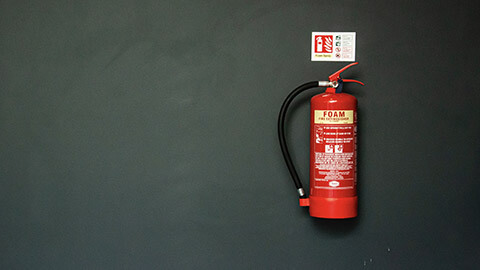
There are several possible causes of fire in the workplace. The most common are:
- unsafe actions by people, such as smoking in areas where flammable materials are present
- unsafe conditions, such as overloading electrical circuits, unsafe wiring and incorrect fuse sizes
- electrical malfunctions
- unsuitable storage of combustible materials
- friction, such as conveyor belts
- chemicals and liquids with low flash points (which evaporate at room temperature to create an explosive air/vapour mixture)
- flammable gases and vapours
- cleaning solvents
- oxygen tank may catch fire and/or explode.
Not all fires are the same. Depending on what is burning, they are classified differently:
- CLASS A (water, dry powder, AFF foam spray & wet chemical) - combustible material such as wood, paper and fabric
- CLASS B (dry powder and CO2) - flammable liquid such as petrol, kerosene and alcohol
- CLASS C (dry powder) - flammable gas such as LPG and butane
- CLASS D (dry powder) - combustible metals such as potassium, sodium and aluminium
- CLASS E (dry powder and CO2) - electrical hazards
- CLASS F (wet chemical) - cooking fats and oils.
Fire extinguishers are essential equipment in workplaces. They are best used for small fires that can be doused with an extinguisher. Extinguishers are a requirement in every workplace, regardless of other firefighting equipment. The extinguishers must be regularly checked, maintained and replaced as necessary to remain effective.
It is also important that the location of the extinguishers is visible and easily accessible for anyone who needs them. Should they be in an area that isn’t directly visible, there must be clear signage directing people to the extinguishers.
Different extinguishers should be used for certain fire classifications.
The most common types of fire extinguishers are:
- Identification - Solid red coloured canister.
- Used for - Class A: wood, paper and cloth.
- Warnings - NEVER use a water fire extinguisher on flammable liquid or an electrical fire. Water will only spread flammable liquid, which will most likely spread the fire, and in the case of an electrical fire, water may conduct the electrical current, which can electrocute you.
- Identification - Red canister with a white band.
- Used for - Class A: wood, paper and cloth, Class B: flammable liquid and Class C: flammable gas, Class D: combustible metals, Class E: electrical fires.
- Identification - Red canister with a black band and a large shield nozzle.
- Used for - Class B: flammable gas and Class E: electrical fires.
- Warnings - DO NOT USE wood, paper, textiles on Class A fires.
- Identification - Red canister with a blue band.
- Used for - Class A: wood, paper and cloth and Class B: flammable liquid fires.
- Warnings - DO NOT USE on electrical fires or flammable metal fires.
- Identification - Red pouch with the words 'FIRE BLANKET' printed on the label.
- Used for - Smothering all types of fires but especially good for kitchen fires, small bin fires and wrapping around a person whose clothes are burning.
- Identification - Red canister with a yellow band.
- Used for - Class A: wood, paper and cloth and Class F: cooking oils and deep fat fires.
- Warnings - DO NOT USE on electrical, flammable liquid or flammable gas fires.
Watch
Watch the next video to explain the different types of fire extinguishers that can be used.
The next video provides a visual explanation on how to use a fire extinguisher.
When operating a fire extinguisher, you will need to remember the acronym P.A.S.S.
- PULL the pin. This allows you to operate the extinguisher.
- AIM at the base of the fire. This is where the fire fuel is.
- SQUEEZE the top handle or lever. This releases the pressurised extinguishing agent in the extinguisher.
- SWEEP from side to side until the fire is completely extinguished. Start using the extinguisher at a safe distance away and then start moving in closer as the fire diminishes. Once the fire is extinguished, keep an eye on the area in case it re-ignites.
If you work in a position where there is a high fire risk, then you should arrange to attend a hands-on fire extinguisher training program.
Watch
The next video explains the PASS technique.
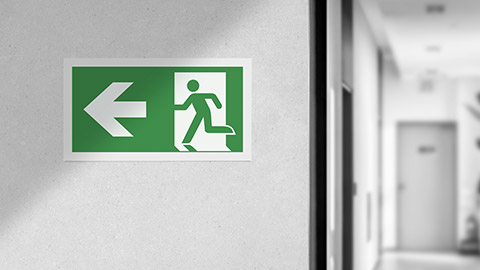
Emergency evacuations refer to emergencies that require a building or facility to have all people and, in this case, animals removed safely until the threat has been removed or minimised. Check your workplace policy on removing animals in emergency situations. Human safety is paramount, and in some emergency situations, you may be required to leave the animals behind. Emergencies that require evacuations can include any of the following:
- extreme weather, including flooding, and bushfires (some of these emergencies are predicted, and you will be notified whether you are required to evacuate)
- toxic chemical leaks and spills, including gas
- bomb threats
- explosions
- internal fire
- structural collapse
If there is a fire or other type of emergency that requires an emergency evacuation, the following 6 steps should be observed:
- Remain calm - do not panic, as this doesn't achieve anything and can scare others.
- Alert others - verbally advise others and/or set off the fire alarm.
- Call 000 - advise them of the type of emergency. The fire brigade will probably be the main responder as they deal with fire, bomb threats, toxic spills and hazardous waste. However, the police or an ambulance may also be required.
- Safely contain or control the situation (if possible) - if the situation is a fire, then close doors or use fire extinguishers, but only if it is safe.
- Evacuate calmly - if there is smoke in the vicinity, stay low and cover your nose and mouth. Inform others of the need to evacuate. If your workplace has one, follow the directions of the Fire Warden. These people are specially trained in emergency evacuations and have the responsibility to ensure everyone in the building gets out safely and is accounted for.
- Assemble at a designated area - and wait for the emergency services. They will advise when it is safe to re-enter the building.
If the fire is the same size or smaller than a paper bin, does not spread quickly, and you know the main fuel involved, you may attempt to fight the fire using the correct fire extinguisher. However, if attempting to fight the fire puts yourself or others in further danger, the extinguisher is not having a positive effect on the fire, or it's not extinguished in 30 seconds, you must cease fighting the fire and commence evacuation procedures.
As a consequence of evacuation, especially in the animal care industry, animals can become lost. It is important to follow workplace procedures in regard to animals in an evacuation. Other consequences include loss of equipment or stock if you have had to evacuate due to flooding or fire and disruption to normal business operations, which in turn results in a loss of income.
Consider if there are people with hearing impairment, vision impairment, are in wheelchairs or have intellectual disabilities. Make them aware of the emergency and the need to evacuate promptly, and provide assistance as required.
What to Look Out For?
In an animal care clinic or in any building, there should be emergency evacuation diagrams posted on the walls to help you identify where you are in the building and the appropriate route to get to safety in an emergency.
Here are some examples of what the evacuation plans may look like in the animal care facility. Make sure you look/familiarise yourself with them.
On this diagram, you can see the following:
- The best evacuation route is highlighted in green
- Where fire extinguishers are located in the facility and the types they are
- First Aid room
- Route to the assembly area outside
Make sure that when you commence SWLA or even work at a facility, you familiarise yourself with this document and its procedures.
Emergency Evacuation Signs You Need to Be Familiar With
- Evacuation Assembly Point
- Emergency Assembly Point
- Exit Signs
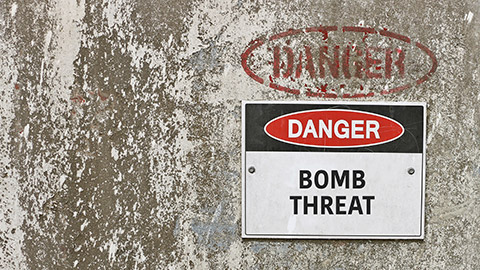
Bomb threats are threats that indicate a building or facility has an explosive device somewhere on the premises. In many cases, bomb threats can be made over the telephone from an anonymous caller informing the facility there has been a bomb or explosive device planted or an individual has entered the facility with an explosive device strapped to their person. Regardless of the threat, they must be taken seriously, and specific procedures must be in place to ensure the safety of all in the building.
If you receive a bomb threat via the telephone, follow these guidelines:
- Keep the caller talking (do not hang up) as this may assist in tracing the call.
- Remain calm and do not say or do anything that may encourage irrational behaviour.
- Notify a colleague or your supervisor as soon as possible and have them call 000.
- Take notes of exact words or phrases that the caller uses. For example, the time of the call, any information that they provide such as when the detonation is supposed to happen, identifying features of the caller such as gender, approximate age, accent, and background noises.
- Switch off mobile phones and ensure others in the workplace do the same as they can be used as remote detonators.
- Check the immediate work area and public areas for any suspicious packages or bags.
- Do not evacuate unless your manager/supervisor or the police/fire personnel advise you to do so.
Consequences of a bomb threat or explosion include:
- fear and anxiety in workers and clients (both people on-site and those notified of the event)
- loss of lives, both animals and humans
- loss of business
- damage to property.
Watch
The next video is a demonstration on what to do if there is a bomb threat at your business.
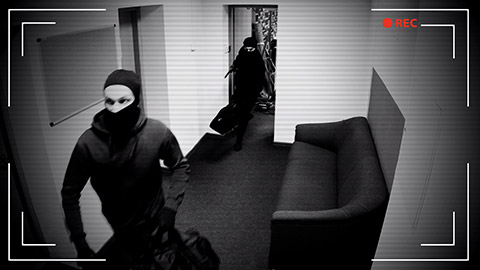
Armed hold-ups are a very real concern for the business community. Armed hold-ups are emergencies that involve an armed person or people. These individuals may be armed with a firearm such as a gun or a knife. Some of these offenders can be violent and aggressive and may be suffering from a severe mental illness, or their behaviours could be the result of substance abuse. Commonly, armed hold-ups are caused by a demand for money or, in some cases, prescription drugs.
Employers and employees can follow precautions to prevent an armed hold-up or, at the very least, be able to assist police with a detailed description of the offender.
Some of the precautions that need to be considered to prevent an armed hold-up have been outlined in the following list.
- Cash register areas should be designed to deter thieves by ensuring members of the public cannot access the terminal. CCTV should be positioned over the cash register area.
- Ensure that members of the public cannot gain access to restricted staff areas (stock rooms, behind the counter, staff rooms).
- Be wary of early and late 'customers' and people behaving suspiciously or loitering near the premises.
- Utilise signage such as 'Please remove helmets before entering the building'.
- Practice taking mental descriptions of people and vehicles. For example, clothing, height, weight, tattoos, jewellery, property carried, car make, model, colour and year of manufacture.
- If the premises have an alarm or duress button installed, ensure that all staff has training in how to use it.
- Have emergency numbers handy, and if the telephone system has a speed dial, use it to program emergency numbers.
- Keep doors locked until all money is secured in the cash register (opening), and lock them before reconciling and depositing takings in the safe (closing).
- Have a height chart on the exit door.
In the event of a hold-up:
- Do what you are told, no more, no less.
- Try to memorise the details of the offender, including their vehicle. Write these details down as soon as you get the opportunity.
- If the workplace has a duress alarm, activate it as soon as it is safe to do so.
- As soon as the offender leaves, lock the doors and cease trading. Ask any customers who were present at the time of the hold-up to remain behind as witnesses.
- Ring 000 and ask for the police.
- Do not touch anything. Isolate the areas the offender has been in and do not contaminate the crime scene.
Consequences of a security breach, including intruders or disturbed persons, include:
- fear and anxiety in workers and clients at the facility
- loss of lives if weapons were used (both humans and animals)
- loss of business
- damage to property.

External emergencies are those that occur outside of the workplace. They can be divided into either natural disasters such as weather emergencies or traffic emergencies.
Weather Emergencies
Weather emergencies are uncontrollable natural disasters that can result in severe damage, destruction, injury and sometimes death. They can, on occasions be predicted, however, the severity of some of these natural occurrences is often underestimated.
Weather emergencies are caused by any of the following:
- thunderstorms, including cyclones or hurricanes
- floods
- bushfires.
It is important to understand the most extreme of circumstances will require the evacuation of the facility and even the community.
State governments and local councils will often have an alert system in place that you can register for. This provides text message warnings if a weather-related event is expected for your immediate area. It is worth researching if such a service exists in your state/territory or city/town and registering for the alerts.
These types of emergencies can cause loss of power or clean water supply, structural collapse/damage and interior flooding. Having a workplace policy for dealing with weather-related emergencies is advisable, especially if your place of employment is in an area highly prone to these types of events. For example, North Queensland is susceptible to cyclones and thus structural damage, floods, power and clean water loss. Damage to the premises and also stress to animals can be caused by extreme weather events.
A flood has the ability to submerge a workplace along with everything in it (animals, humans, equipment, machinery and furniture), causing much damage.
Animals and humans are likely to get swept away and stuck in dangerous situations, causing serious injury and even death due to drowning. Some other consequences could be:
- evacuation
- damage to property and business
- stress to humans and animals
- injuries to humans and animals
- disruption to the business.
If your workplace does not currently have a weather emergency policy in place, then suggest it to your supervisor. Things to consider when formulating this type of policy:
- Back-up power sources, such as generators or batteries, are needed.
- Alternative housing arrangements for animals - other establishments that offer a similar service to yours. You might be able to return the favour to them if need be.
- Insurance - hopefully this is already in place, however, the policy could refer to the applicable insurance policy and indicate the location of the policy documents so they can be accessed easily.
- Duties for specific employees - is someone going to be responsible for first aid? Is another person responsible for organising repairs? Who will be responsible for moving animals to a safe location?
- Contact numbers for assistance personnel - 000 should be used for immediate emergencies. However, there may also be a State Emergency Service (SES) number you can call, as well as a veterinarian contact.
- Transport limitations - it is advisable not to drive during severe weather events as roads can be closed or obstructed. Have a backup plan in place if employees are unable to travel to a particular location or make it to work. The policy should caution staff about the dangers of driving through floodwater and advise them to always pay attention to signs, barricades and emergency personnel.
Traffic Accidents
Other external emergencies may occur outside, including traffic accidents. It is not uncommon to find severe accidents causing road closures and traffic congestion. Traffic accidents can involve:
- collisions with other vehicles or pedestrians, causing injury
- trucks turning over
- oil spills from engine fluid
- animals being brought in or out of the animal care facility run over or injured due to vehicles driving into the facility's parking area.
Compensation may need to be paid to the affected individuals for damage to them, their animals and/or vehicles and property.
Tip
Just remember that these external emergencies can cause issues for animals outside. These events can cause an influx of animals requiring treatment, care and assistance.

Internal emergencies, as the name suggests, are emergencies that occur inside the workplace that require immediate action and can cause harm or injury to those who are inside the facility or building.
In addition to weather, there are also internal emergencies that take place, some of which include:
- loss of power
- water supply
- structural collapse
Loss of Power
Loss of power can come from more than just wild weather. There may be a power outage in the area, faults or malfunctions in electrical work, or issues with the power supply in the facility. Loss of power can have severe implications on the running of the facility, especially when there are certain types of medical equipment, computers, refrigeration for medication, and air conditioning relying heavily on electricity. Many facilities will have a backup generator that will kick in with the loss of power and offer a power supply to keep the facility operating until regular power can be restored.
Water Supply
Similar to a loss of power, a loss of water can have dire consequences for a veterinary clinic. Loss of water supply can come from burst water piping in the streets, cutting off supplies to the clinic and surrounding community, or a malfunctioning hot water system on the premises. Without an adequate water supply, hygiene will be compromised as there will be nowhere to wash hands without running water. The water supply for animals and people will not be replenished. In the event of issues with the water supply, you must notify management to determine the best course of action.
Structural Collapse
Structural collapses can range from whole buildings to partial collapses from the roof. Roof collapses can result from wild weather, causing water to seep into the ceiling from damaged piping. Water may seep into the roof cavity, weakening it and causing the roof to cave in and damage the interior of the facility. In some cases, wires from lighting can also be damaged and, if in contact with water, can make the area unsafe and unusable.

Injuries inflicted as a result of animal bites and scratches are a very real hazard in the animal care industry. In addition to the pain and discomfort, there is a risk of infection. In serious cases of injury, surgical intervention may be required.
The risk of being bitten is usually increased by:
- a disruption in routine for the animal
- being frightened by strange noises
- reactions to strange people and animals
- Inappropriate handling of animals causes pain, discomfort, and distress.
The risk of bites and scratches is greatly reduced by:
- correct animal handling training
- being able to observe animal behaviour and knowing when it may try to escape or become aggressive
- avoiding circumstances that may cause the animal to try to escape or react due to fear.
In the event of an injury, the following steps must be taken to prevent further injury to staff and animals:
- Secure the animal (or have someone with the correct knowledge assist if you are unable to do this).
- For minor cuts, scrapes, or bites, bathe the affected area with an antiseptic solution (such as iodine). Note - do not bathe or wash the site of a venomous snake bite or a major wound that has an open laceration. Leave that to medical experts.
- Apply basic first aid, such as dressings, to control bleeding.
- Seek medical advice or assistance for more serious injuries.
- Notify your supervisor of the injury and complete a workplace incident report form.
- If bitten, you should seek medical attention as bites can cause serious infections.
Medical Emergencies
Other types of medical emergencies may include:
Cardiac Arrest/Heart Attack
Perform the DRSABCD emergency response process:
- Danger - check for any immediate danger to yourself, the victim or others.
- Response - check if the victim responds to a stimulus, call their name and touch them gently.
- Send for help - get someone to call 000 and request an ambulance, or if you are alone with the victim, then do so yourself (put the phone on speakerphone).
- Airway - Check that the victim's airway is clear. Items such as false teeth, vomit, and food can create blockages.
- Breathing - is the victim breathing? If not, then commence mouth-to-mouth resuscitation.
- Circulation - does the victim have a pulse/heartbeat? If not, then commence Cardio Pulmonary Resuscitation (CPR).
- Defibrillation - if your workplace has a defibrillation device then you can utilise it to regulate the heart rhythm. Follow the voice prompts on the device.
Watch
Here are some videos to help explain the DRABCD protocol.
Electrical Shock
Do not touch anyone who has received an electric shock until the power supply has been cut off at the mains. Often, someone who has been electrocuted will need to be resuscitated.
Allergic Reaction
Severe allergic reactions are known as anaphylaxis. People who have a tendency to suffer these types of medical emergencies will often have an auto-injector of medicine (known as an EpiPen), or your workplace first aid kit may contain one. Follow the administration instructions on the EpiPen.
Burns
Run the wound under cold water for around twenty minutes. Carefully remove any clothing (unless the fabric is stuck to the skin; in this case, leave it) and cover the wound with a clean, dry dressing. Seek medical attention for any burn that is larger than a twenty-cent piece or if it is oozing or extremely painful after basic treatment.
Providing immediate and effective first aid to workers or others who have been injured or become ill in the workplace may be the difference between life and death. Each workplace should have a:
- fully stocked first aid kit ready for use that is easily accessible
- the representative who is trained in first aid and rostered during each shift.
If your workplace doesn't have these items or employees with training, discuss this with your supervisor. Potentially you could volunteer to set up a first aid kit or attend first aid training. Safe Work Australia has produced a Code of Practice called First Aid In The Workplace which may assist.

Hazardous substances have the potential to cause harm to the body. They may also endanger the environment if not disposed of correctly and have severe consequences if they leak or spill. The severity of a hazardous substance or chemical spill will depend on the type of substance that is being used. Some are more dangerous than others.
Incidents
Major incident: an event where a highly toxic substance is uncontrollably released into the environment such as a gas leak, fumes, or smoke.
Minor incident: an event where there is a small spill of a cleaning substance, such as bleach or a disinfecting agent.
These incidents can cause the following hazards to both humans and animals:
- smoke inhalation
- inhalation of noxious gases
- absorption of toxins via the skin
- chemical burns
- slips, trips and falls.
Both incidents require action. However, one will require evacuation and emergency services assistance, whereas the other will require a basic clean-up using personal protective equipment and suitable cleaning equipment.
A Safety Data Sheet (SDS)
A Safety Data Sheet (SDS) is an information document that, by law, a manufacturer must provide with the initial sale of any hazardous substance. An SDS provides information required to assess the health risks and handling procedures associated with any potentially hazardous substance.
SDS's provide the following:
- introductory details, including date of issue and hazardous nature, for example, if the item is poisonous
- manufacturer's details, including address and phone number
- product information, including physical description, properties and ingredients
- health hazard information, including health effects, first aid and advice to doctors
- precautions for use, including general precautions, personal protection requirements, volatility and flammability
- safe handling information, including storage and transport, spills and disposal and information on whether it is a fire or explosion hazard.
Major Incident Response
- Do not touch any hazardous substance or approach the immediate area. Instead, try to seal off the area by closing doors.
- Protect yourself with adequate personal protective equipment, which may include ventilation equipment.
- Raise the alarm, call 000 and advise them of the nature of the incident and the type of substance involved.
- Evacuate persons not involved in the contamination response.
- If it is safe to do so, evacuate animals also, although only if they are at immediate risk of injury or illness. If they are contained in another room or area, it may be safer to leave them where they are.
- Follow the directions of emergency personnel.
Minor Incident Response
- Take care to protect yourself with appropriate personal protective equipment such as gloves, goggles and other items as required.
- Remember that chemical odours can become quite overpowering in closed areas. Allow adequate ventilation if possible.
- Refer to the relevant Safety Data Sheet (SDS) for advice on how to clean up a particular substance.
- Dispose of the actual substance and any associated single-use cleaning items according to the hazardous waste guidelines on the SDS.
- Dispose of any contaminated equipment or materials if required.
- Advise colleagues and your supervisor of the spill, the clean-up that has been performed, and any other actions they need to be aware of. Use signage to warn about wet floors or odours if necessary.
Below is an extract from an SDS sheet from Happy Paws Animal Care.
Watch
The next videos explain an SDS sheet and its uses.
Some examples of hazardous substances and chemicals you may encounter in your work with animals include:
In the animal care industry, staff may encounter several hazardous substances and chemicals during daily operations. These substances can pose risks to both humans and animals if not handled properly. Here are some examples:
Disinfectants and Cleaning Agents
- Examples: Bleach, quaternary ammonium compounds, hydrogen peroxide, and phenol-based disinfectants.
- Hazards: These chemicals can cause skin irritation, respiratory issues, and eye damage if not used correctly. They may also be toxic to animals if ingested or if they come into direct contact with their skin.
Pesticides and Insecticides
- Examples: Pyrethrin-based flea sprays, rodenticides, and ant baits.
- Hazards: Pesticides can be highly toxic to both animals and humans, leading to poisoning if ingested or absorbed through the skin. Inhalation of fumes can also cause respiratory issues.
Medications and Pharmaceuticals
- Examples: Antibiotics, anesthetics, anti-inflammatory drugs, and vaccines.
- Hazards: Misuse or accidental exposure to these substances can cause allergic reactions, toxicity, or other health issues in both humans and animals. Some medications may be harmful if handled without proper protection.
Chemical Restraints
- Examples: Tranquilizers and sedatives used to calm or restrain animals during procedures.
- Hazards: Accidental exposure to these chemicals can cause dizziness, drowsiness, or even unconsciousness in humans. Overexposure to animals can lead to overdose or adverse reactions.
Cleaning and Grooming Products
- Examples: Shampoos, conditioners, flea treatments, and ear cleaners.
- Hazards: Some grooming products contain chemicals that can irritate the skin, eyes, or respiratory system. Ingestion by animals can lead to poisoning or gastrointestinal distress.
Fertilizers and Plant Treatments
- Examples: Fertilizers, weed killers, and fungicides used in landscaping or animal enclosures.
- Hazards: These chemicals can be toxic if ingested or inhaled by animals. They may also cause skin irritation or burns in humans.
Enzymatic Cleaners
- Examples: Products used to break down organic waste, such as urine or feces.
- Hazards: While generally safe, some enzymatic cleaners can still cause skin or eye irritation if handled improperly. Ingestion by animals can cause gastrointestinal upset.
Veterinary Laboratory Chemicals
- Examples: Formalin, xylene, and other chemicals used in diagnostic labs for tissue preservation or testing.
- Hazards: These chemicals can be highly toxic, carcinogenic, or corrosive, posing significant health risks if inhaled, ingested, or if they come into contact with skin.
Adhesives and Sealants
- Examples: Surgical adhesives, wound sealants, and materials used in enclosure maintenance.
- Hazards: These substances can be harmful if inhaled or if they come into contact with skin. They may also pose a risk of poisoning if ingested by animals.
Waste Products
- Examples: Animal waste, soiled bedding, and biohazardous waste.
- Hazards: Waste products can carry harmful bacteria, viruses, or parasites, posing a risk of infection or disease transmission to both animals and humans.
Also
In an animal care setting, managing bodily fluids—such as urine, feces, vomit, blood, saliva, and mucus—is a routine aspect of maintaining animal health and hygiene. These fluids can provide valuable insights into an animal's well-being, as changes in color, consistency, or frequency can indicate health issues such as infections, dehydration, or injury. Proper handling, disposal, and cleaning of areas contaminated by bodily fluids are crucial to prevent the spread of disease, protect staff, and ensure the animals' environment remains clean and safe. Personal protective equipment (PPE) and sanitation protocols are essential for safeguarding both animals and caregivers.

You may have heard the phrase;
Prevention is better than cureDesiderius Erasmus
Infection control is an integral part of your responsibility as an animal care worker. When you are considering infection control, it is important to maintain a very high level of hygiene practices to reduce the spread of infection.1
We are no stranger to regularly sanitizing hands or wearing a mask, and the reasons for these practices to be put in place are purely to help prevent the spread of infections. As you will have come to learn, several zoonotic diseases can be transferred from animals to humans. Appropriate infection control can minimise the spread of these diseases and prevent humans and animals from becoming contaminated.

Cleaning and Disinfecting
Where animals are concerned, the environments you work in can become exposed to contamination very quickly. Therefore, appropriate cleaning and disinfecting tasks need to take place to help prevent any spread of infection. To maximise the effectiveness of infection control, a combination of cleaning and disinfecting should become a part of regular cleaning responsibilities.1
It is important to consider that cleaning and disinfecting methods may vary depending on the surface or the type of equipment you are using. For example, you would not use the same cleaning equipment to clean kennels, pens, or cage flooring in the kitchen. You would also need to apply a certain procedure for cleaning clippers or surgery equipment. All staff must be trained properly when it comes to cleaning and familiarise themselves with the relevant safety data sheet for the chemicals they are using.1
Cleaning
When cleaning dirt, food, cat litter, faeces, or bodily discharge such as blood, urine and vomit, you should consider the following procedure:
- Wear gloves, a face mask and appropriate protective clothing if it is likely the matter will splash (it is preferred to use disposable clothing that can be thrown out afterwards).
- Remove any faeces, dirt or bodily discharge before you start cleaning. Any loose dirt or dust should be removed with a cyclonic vacuum cleaner with a HEPA filter.
- Sweep with a broom before mopping.
- Use detergent or soap to remove any stubborn dirt, scrubbing the area if necessary.
- Once the area has been cleared of dust or dirt, the area needs to be mopped with the appropriate product and mop.1
Disinfecting
Disinfecting should take place after you have finished cleaning the area. The use of disinfectants can maximise the cleanliness of the area and reduce the spread of infection. The following procedure outlines the steps that should be taken when using a disinfectant:
- Ensure the area is well-ventilated.
- Wear gloves, a face mask and safety glasses (for situations that may cause splashing).
- Correctly dilute the quantity of disinfectant you need according to the SDS. The disinfectant must be carefully selected according to the soiled area it targets and appropriately measured. It is important to consider the concentration of disinfectants. Some may be stronger than others to specifically target infections with a higher risk of contagiousness.
- Ensure you have left the disinfecting agent on the surface for the allocated contact time before wiping it if instructed.
- Rinse the area of any residual disinfectant on surfaces where any patients, staff and other people may come into contact with it, such as a cat's housing cage.
- Ensure areas have completely dried before attending to the next patient. 1
Fun fact
Did you know it is advised pregnant women should not handle cat litter boxes?
Isolation
In addition to regularly washing hands, sanitising and wearing masks when in contact with contagious diseases, isolation is a control that can be implemented. Upon discovering a contagious disease, the animal will need to be isolated.1
Isolation Wards
An isolation ward (ISO-W) is essential for all animal/veterinary hospitals. All ISO-W in the hospital need to be low-traffic and separate from the rest of the hospital. This includes having an alternative entry and exit to restrict people from walking through the general hospital and treatment wards. Purpose-built ISO-W should be equipped with a separate ventilation system from the hospital, where extraction fans direct the airflow outside to prevent airborne illnesses from spreading through the hospital’s ventilation system. ISO-W will usually have an area where a footbath or foot mat is located. 1
Footbaths and Foot Mats
Footbaths and foot mats are located at the entry/exit to the isolation ward, where shoes can be disinfected before entering any other part of the hospital to prevent cross-contamination. They are an integral aspect of infection control.1
Footbaths are shallow containers containing a disinfectant solution. Foot mats are made of spongy material that is saturated with a disinfectant solution, where you would simply stand on the mat to soak the bottom of the shoes with the solution. Regardless of whether you are wearing disposable foot covers, you should always ensure you have used the footbath/mat before you leave the ISO-W and travel to any other part of the hospital. When using a footbath or mat, the following needs to be considered:
- The solution should be changed daily as persistent organic matter within disinfectants reduces the effectiveness.
- It is important to consider the type of solution used and the frequency it needs to be changed, as some forms of bacteria require a higher level of disinfectant than others to destroy the bacteria present.
- Ensure WHS has been considered because these areas can become slippery if there are spills or the bottom of the shoes are wet. 1
Working in the ISO-W
The ISO-W must be identified with appropriate signage, including the PPE that is required before entering the ward (some signs should be erected around the ward to identify appropriate PPE). ISO-W staff need to be properly inducted and trained according to the ISO-W’s standard operating procedures. Once the patient has been triaged and suspected to have a contagious disease, they need to be admitted directly to the ISO-W for treatment via a separate entrance to the rest of the hospital. Staff in the ISO-W need to ensure they have signed in and out using the facility's logbooks (these are usually located on the outside of the ward and should remain in the same spot for quick accessibility). It is important that only delegated staff and patient owners are to enter the ISO-W.1
All equipment that is used in the ISO-W is to be kept separate from other equipment and appropriately disinfected and cleaned between uses, particularly stethoscopes and thermometers. Do not remove any equipment from the ISO-W unless it is being disposed of. All equipment and PPE must be disposed of according to the appropriate disposal containers. (These containers have clear identifiers, including images, so you know which type of equipment goes in which container.) Whatever materials you use, including blankets, must be treated as though they are contaminated and need to be washed separately from all other laundry items. The ISO-W would generally be equipped with a laundry facility separate from that of the general hospital. Depending on the type of infection you are dealing with, it may be better to use disposable bedding such as puppy pads or dispose of any bedding as biological waste to prevent the infection from spreading. 1
Procedure
The following are some of the procedures that should be considered when using an ISO-W in a veterinary hospital.
- Sign in to the ward using the facility's logbook.
- Ensure footwear has been covered with disposable foot covers before entering the ISO-W. If you are not using your everyday footwear and have a separate pair, these shoes need to be donned and the everyday footwear left at the entrance of the isolated room.
- Wash hands thoroughly and apply double gloves before treating the patient.
- Wear appropriate PPE, including face masks and disposable clothing if instructed.
- Consult with the triaged patient.
- Once triage and treatment have been completed, clean the surface with the appropriate level of disinfectant and allow it to stand for the allocated time before treating any other patient.
- Dispose of any equipment in the appropriate containers.
- Thoroughly wash your hands with soap and sanitiser after treatment and cleaning.
- Dispose of nitrile gloves in biological waste.
- Remove shoe covers and dispose of them in biological waste.
- Ensure shoes have been properly washed in a footbath with an appropriate disinfectant solution or shoes have been cleaned on a foot mat before entering any other part of the hospital to prevent any cross-contamination. Shoes should undergo this process regardless of wearing foot covers or not.1
Fun fact
Did you know, any gowns that are used in the ISO-W that are not disposed of need to be laundered separately and washed at a minimum temperature of 40 degrees Celsius?1
A final note on working in the ISO-W. Effective communication must take place between the staff. The lines of communication must always be open because you are working in a ward where infection can be spread if communication is not adhered to. In these settings, text messages or emails are a quick and efficient way to report suspected infection and act swiftly. 1
Cleaning Equipment and Other Items
There are several items you will need to consider regarding cleaning when working in either the ISO-W or in the general veterinary hospital. The following table illustrates the type of equipment and cleaning technique that should be applied.1
| Type of equipment | Cleaning technique |
|---|---|
| Food and water bowls |
|
| Thermometers |
|
| Cat litter boxes |
|
| Stethoscopes |
|
| Clippers |
|

The animal care industry has several common hazards that can occur in the workplace. For each of these hazards, there are control measures that can be implemented so workers and visitors are not exposed to the risks from these potential hazards.
Workplace Hazards in the Animal Care Industry
The most common workplace hazards in any animal care facility include:
- Animal handling
- Zoonotic disease
- Psychological hazards
- Ergonomic hazards
- Physical hazards
- Chemical hazards
- Hazards from machinery and equipment
- Radiation hazards
- Clinical and biological waste
Effective risk management involves four steps which must be documented within policies and procedures and also followed by all personnel.
- Identify Hazards - Find out what could cause harm. These may be hazards caused by animals, chemicals, biological elements, and/or radiation, to name a few.
- Assess Risks - Understand the likelihood of a hazard causing harm and how serious it could be.
- Control Risks - Implement the most effective control measure that is reasonably practicable in the circumstances.
- Review Control Measures - Set up a regular schedule of review to ensure the most effective control measure is being used and also that it is working as planned.
Animal Handling

Animal handling is a very common task in the animal care industry and presents a very likely risk of injury. Caution should be taken whenever handling animals.
It is important to always observe an animal’s behaviour prior to approaching or handling it. By observing the behaviour and temperament of an animal we can better understand how we should approach and handle the animal. This also allows you to decide the most appropriate restraint technique and if additional equipment is required for your safety and the safety of the animal.
Other hazards, such as zoonotic diseases, may also present themselves when handling animals. To reduce the risk of spreading infection or contracting a disease, it is best practice to use effective personal hygiene strategies such as handwashing. Be cautious and use appropriate personal protective equipment when being exposed to animal saliva, blood, faeces, urine, vomit and placenta.
| Hazards when handling animals | Control Methods |
|---|---|
| Animal bites and scratches |
|
| Kicks, crush injuries, charging & trampling |
|
| Envenomation |
|
| Zoonotic diseases |
|
Chemical Hazards
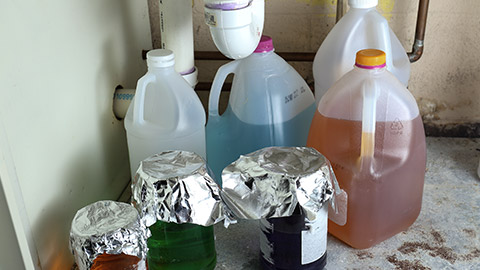
Chemical hazards are hazards that may occur when using chemicals in the workplace. You will use Chemicals such as disinfectants daily in the animal care industry. If your skin, airway, or membranes are exposed to chemicals, there is a risk of injury or illness. Some examples of chemical hazards include:
- Sterilising chemicals – disinfectants
- Solvents
When handling and using hazardous chemicals, it is extremely important to wear appropriate personal protective equipment and only use the chemicals as instructed on the safety label. This includes diluting the chemicals safely and according to the manufacturer’s instructions. You should always read the MSDS/SDS if exposed to hazardous chemicals and seek medical advice.
| Exposure to chemicals |
|
Animal Medication
There are different types of medications used in the animal care industry. These include anesthetics, chemotherapy drugs, medicated shampoos, antibiotics, and preventative medications such as flea and tick treatments.
Depending on your workplace, you may or may not be exposed to all these medications. Each category of medication poses different risks to workers.
To ensure any risk is minimised, the following should be practised:
- Medication must be clearly labelled.
- Manufacturer's instructions should always be followed.
- Personal protective equipment, such as gloves, should be worn when handling all medications. Extra PPE may be required when handling medications like chemotherapy drugs.
- Medications must be disposed of according to regulations.
- Drugs should only be handled and administered by a Vet or trained personnel. These drugs have strict recording regulations and need to be kept in a safe attached to the wall or floor of the building.
Some examples of medication that you may interact with in your role may include:
Antibiotics
- Amoxicillin: Used to treat bacterial infections in dogs and cats.
- Cephalexin: Effective against many bacterial infections, including skin infections.
- Doxycycline: Used to treat bacterial infections, including respiratory infections and tick-borne diseases.
Antiparasitics
- Ivermectin treats internal and external parasites such as heartworms, mites, and intestinal worms.
- Fenbendazole: Commonly used to treat gastrointestinal parasites in dogs, cats, and livestock.
- Pyrantel Pamoate: Effective against roundworms and hookworms in pets.
Anti-inflammatory and Pain Relief
- Carprofen: A non-steroidal anti-inflammatory drug (NSAID) used for pain relief and inflammation in dogs.
- Meloxicam: Another NSAID used to manage pain and inflammation in dogs and cats.
- Prednisone: A corticosteroid used to treat inflammation and immune-mediated conditions.
Vaccines
- Rabies Vaccine: Essential for preventing rabies in dogs, cats, and other animals.
- Distemper Vaccine: Protects dogs against canine distemper virus.
- Feline Leukemia Vaccine: Protects cats against feline leukemia virus.
Antifungals
- Ketoconazole: Used to treat fungal infections in dogs and cats.
- Itraconazole: Effective against various fungal infections, including ringworm.
Antivirals
- Acyclovir: Used to treat viral infections such as feline herpesvirus.
- Famciclovir: Another antiviral medication used primarily in cats to treat herpesvirus infections.
Anesthetics and Sedatives
- Acepromazine: A sedative used to calm animals or as a pre-anesthetic.
- Propofol: An injectable anesthetic used for induction and maintenance of anesthesia.
Antidiarrheals and Digestive Aids
- Metronidazole: Used to treat gastrointestinal infections and diarrhea.
- Probiotics: Supplements that support healthy gut flora and digestive health.
Cardiovascular Medications
- Enalapril treats heart failure and high blood pressure in dogs and cats.
- Furosemide: A diuretic used to treat fluid retention and edema associated with heart failure.
Hormonal and Endocrine Medications
- Insulin: Used to manage diabetes in dogs and cats.
- Levothyroxine: Treats hypothyroidism in dogs.
Anti-Anxiety and Behavioral Medications
- Fluoxetine: An antidepressant used to treat anxiety and behavioural issues in dogs and cats.
- Clomipramine: Used to manage separation anxiety and obsessive-compulsive behaviours in dogs.
Topical Medications
- Mupirocin: An antibiotic ointment for treating skin infections.
- Hydrocortisone Cream: Used to reduce inflammation and itching on the skin.
Sharps
Sharps refer to objects or instruments that can puncture or cut the skin, posing a significant risk of injury or infection. In the animal care industry, sharps are commonly encountered during medical treatments, animal handling, and facility maintenance.
Types of Sharps
- Needles: Used for injections, vaccinations, blood draws, or animal medication.
- Scalpels and Surgical Instruments: Utilized during surgeries or medical procedures on animals.
- Scissors and Clippers: Used for grooming, cutting bandages, or other veterinary tasks.
- Animal Teeth and Claws: Natural sharps that can cause bites or scratches, potentially leading to infection.
- Broken Glass or Metal: Found in enclosures, cages, or equipment, posing a risk of cuts or punctures.
To reduce the risk of being injured by a sharp, we must:
- Proper Handling: Hand sharps carefully, using appropriate techniques to avoid accidental injury. For example, never recap needles by hand.
- Personal Protective Equipment (PPE): Wear gloves, protective eyewear, and other PPE when working with or around sharps to reduce the risk of injury.
- Sharps Disposal: Dispose of used sharps immediately in designated, puncture-proof sharps containers. Never throw sharps in regular trash bins.
- Training: Provide staff with training on the safe handling of sharps, including proper disposal methods and what to do in case of a sharps injury.
- First Aid Procedures: Have clear protocols for responding to sharps injuries, including cleaning the wound, seeking medical attention, and reporting the incident.
- Animal Handling: When working with animals, use appropriate restraint techniques to minimize the risk of bites or scratches. Be aware of the animal's behaviour to avoid sudden movements that could lead to injury.
- Regular Inspections: Conduct regular inspections of enclosures, equipment, and facilities to identify and address any potential sharp hazards, such as broken glass or protruding metal.
Manual Tasks
Manual tasks require a person to lift, lower, push, pull or carry. Manual tasks include moving, holding, or restraining any person, animal, or thing. An example of a manual task is restraining an animal or lifting a box. If manual tasks are not conducted correctly, they can result in injury. To reduce the likelihood of injury, it is important to use correct manual handling techniques and lifting aids when required.
Noise
Noise in the workplace may be from machinery or a kennel full of dogs barking. Excessive noise can damage your ears and result in hearing loss. Other consequences include interference with speech and concentration, fatigue, and aggression. Personal protective equipment must be worn if you work in a high-noise area. This may be in the form of earmuffs or earplugs. Doors should also be closed between areas to minimize the noise travelling to other workplace areas.
Machinery and Equipment
Machinery and equipment are commonly used in the animal care industry for various tasks, including feeding, cleaning, grooming, and medical procedures. While these tools are essential for efficient operations, they can pose significant hazards if not properly maintained, used, or supervised. These hazards can lead to injury for both staff and animals.
Types of Machinery and Equipment you may encounter
- Feeding Equipment: Automatic feeders, grain mills, and hay balers.
- Cleaning Equipment: Pressure washers, floor scrubbers, and vacuum systems.
- Grooming Tools: Electric clippers, dryers, and trimming shears.
- Veterinary Equipment: X-ray machines, anesthesia machines, and surgical tools.
- Animal Enclosures: Automatic gates, doors, and cage systems.
- Handling Equipment: Hoists, slings, and restraint devices used for moving or restraining animals.
Risks that may occur
- Entanglement: Hair, clothing, or body parts can become entangled in moving parts of machines like clippers, conveyor belts, or rotating blades, leading to serious injuries.
- Crushing: Heavy machinery or equipment, such as automatic gates or doors, can cause crushing injuries if not properly operated or if safety mechanisms fail.
- Electrical Hazards: Electrical equipment, if faulty or improperly maintained, can cause electric shocks or even fires, posing a risk to both staff and animals.
- Noise-Induced Hearing Loss: Prolonged exposure to loud machinery, such as industrial washers or dryers, can lead to hearing damage in humans and stress in animals.
- Pinching or Cutting: Sharp or moving parts of equipment, such as trimming shears or medical devices, can pinch or cut skin, leading to lacerations or amputations.
- Manual Handling Injuries: Lifting or moving heavy equipment without proper technique can lead to musculoskeletal injuries, including strains and sprains.
- Struck-By Hazards: Objects or parts of machinery may become dislodged or fall, posing a risk of being struck by them.
Control measures to assist with risk mitigation
- Regular Maintenance: Ensure that all machinery and equipment are regularly inspected, serviced, and maintained to prevent malfunction or breakdown. Address any issues immediately to avoid potential hazards.
- Safety Training: Provide comprehensive training for staff on the safe operation of machinery and equipment. This includes understanding emergency shut-off procedures and recognizing potential hazards.
- Personal Protective Equipment (PPE): Equip staff with appropriate PPE, such as gloves, hearing protection, safety glasses, and protective clothing, depending on the equipment being used.
- Guarding and Safety Features: Install and maintain safety guards on moving parts of machinery to prevent entanglement or contact with dangerous components. Ensure that all safety features, such as emergency stops, are functional.
- Clear Signage and Instructions: Place clear signage near machinery and equipment to indicate potential hazards and provide operating instructions. This can help prevent accidents caused by improper use.
- Supervision and Monitoring: Ensure that machinery is only operated by trained personnel and that animals are closely monitored when near or interacting with equipment.
- Lockout/Tagout Procedures: Implement lockout/tagout procedures for machinery that is being serviced or repaired to ensure that it cannot be accidentally activated.
- Safe Work Zones: Establish designated areas for machinery operation, keeping animals and non-essential staff at a safe distance to prevent accidental contact or injury.
- Proper Animal Restraint: When using equipment near animals, ensure they are properly restrained to prevent sudden movements that could lead to injury.
Risk Mitigation
Entanglement
- Description:
- Workers or animals can become entangled in moving machinery parts, such as belts, gears, or rotating shafts.
- Examples:
- Loose clothing, hair, or jewellery gets caught in machinery, leading to serious injuries or even fatalities.
- Control Measures:
- Ensure all moving parts are adequately guarded.
- Implement strict dress codes, such as tying back long hair and avoiding loose clothing or jewellery.
- Provide training on safe operating procedures.
Crushing
- Description:
- Machinery and equipment can cause crushing injuries if workers or animals are caught between moving parts or between a machine and a fixed object.
- Examples:
- Being trapped under a lowering gate, caught between a vehicle and a wall, or crushed by a falling object from machinery.
- Control Measures:
- Install proper guarding and safety devices to prevent access to dangerous areas.
- Use barriers or enclosures around hazardous machinery.
- Implement lockout/tagout procedures during maintenance or repair work.
Cutting and Shearing
- Description:
- Machinery with sharp edges, blades, or cutting tools can cause severe lacerations or amputations.
- Examples:
- Injuries from contact with cutting tools like saws, shears, or lawnmowers.
- Control Measures:
- Use machines with safety guards and emergency stop buttons.
- Provide training on the safe use and maintenance of cutting tools and machinery.
- Ensure regular maintenance to keep blades and tools in good working condition.
Struck-by Hazards
- Description:
- Workers or animals can be struck by moving machinery, flying debris, or parts that break off or are ejected from equipment.
- Examples:
- Being hit by a swinging arm of a piece of equipment, debris from grinding or cutting operations, or parts that come loose from machinery.
- Control Measures:
- Maintain safe distances from operating machinery.
- Use personal protective equipment (PPE) such as helmets, face shields, or safety goggles.
- Regularly inspect and maintain equipment to prevent parts from breaking or becoming loose.
Electrical Hazards
- Description:
- Machinery and equipment powered by electricity can pose risks of electric shock, burns, or fires if not properly used or maintained.
- Examples:
- Contact with exposed electrical wiring, faulty electrical components, or using equipment in wet conditions.
- Control Measures:
- Ensure all electrical components are properly insulated and grounded.
- Implement regular inspections and maintenance of electrical equipment.
- Train workers on safe handling of electrical machinery and emergency procedures in case of an electrical incident.
Noise Hazards
- Description:
- Loud machinery can cause hearing damage over time if workers are exposed to high noise levels without proper protection.
- Examples:
- Prolonged exposure to loud equipment like generators, compressors, or machinery used in construction or manufacturing.
- Control Measures:
- Provide hearing protection such as earplugs or earmuffs.
- Implement engineering controls like sound barriers or noise-dampening materials.
- Monitor noise levels regularly and ensure they remain within safe limits.
Vibration Hazards
- Description:
- Prolonged exposure to vibration from machinery can lead to health issues such as hand-arm vibration syndrome (HAVS) or other musculoskeletal disorders.
- Examples:
- Operating vibrating tools like power drills, chainsaws, or heavy equipment.
- Control Measures:
- Use vibration-dampening tools and equipment.
- Limit the amount of time workers spend using vibrating machinery.
- Provide training on proper techniques to minimize vibration exposure.
Chemical Hazards
- Description:
- Some machinery and equipment may require the use of chemicals (e.g., lubricants, coolants, or cleaning agents) that can be hazardous if improperly handled.
- Examples:
- Exposure to toxic fumes, skin contact with harmful chemicals, or accidental ingestion of chemicals used in machinery maintenance.
- Control Measures:
- Use appropriate PPE such as gloves, masks, or protective clothing.
- Provide proper ventilation in areas where chemicals are used.
- Ensure all chemicals are labelled, stored, and disposed of according to safety regulations.
Ergonomic Hazards
- Description:
- Poorly designed machinery or workstations can lead to repetitive strain injuries or musculoskeletal disorders.
- Examples:
- Straining to reach controls, lifting heavy machine parts without assistance, or operating machinery in awkward postures.
- Control Measures:
- Design workstations and machinery controls to fit the user's needs, reducing strain.
- Implement mechanical aids for lifting or moving heavy parts.
- Train workers on proper ergonomics and safe handling techniques.
Fire and Explosion Hazards
-
Description:
- Machines that generate heat and sparks or use flammable materials can pose risks for fire or explosion.
- Examples:
- Fires are caused by overheated machinery sparks igniting flammable materials or explosions from gas leaks or improper use of fuel-powered equipment.
- Control Measures:
- Implement regular maintenance to prevent overheating or malfunctioning.
- Store flammable materials away from heat sources and use in well-ventilated areas.
- Provide fire extinguishers and train workers on emergency fire procedures.
Spills
- Description:
- Spills in an animal care facility can occur when liquids such as water, cleaning solutions, chemicals, or animal waste are accidentally released onto the floor. These spills can create slippery surfaces, leading to slip-and-fall accidents, chemical exposure, or contamination.
- Examples:
- Water spilled from animal drinking stations or during cleaning.
- Urine or feces from animals on the floor.
- Cleaning chemicals or disinfectants accidentally knocked over.
- Control Measures:
- Immediate Clean-Up: Implement procedures for the prompt and thorough cleaning of spills.
- Signage: Use "Wet Floor" signs to warn staff and visitors of slip hazards.
- Proper Storage: Store chemicals and cleaning supplies securely to prevent accidental spills.
- Protective Gear: Equip staff with non-slip footwear and gloves to protect against exposure and reduce the risk of falls.
Gravity
- Description:
- Gravity-related hazards involve injuries resulting from falling objects, animals, or people. This can include animals jumping or falling from heights, objects being dropped or knocked over, or staff or visitors tripping and falling.
- Examples:
- Animals climbing or jumping from elevated structures like cages, tables, or play areas.
- Objects such as equipment, tools, or supplies falling from shelves or ledges.
- Staff or visitors tripping over uneven surfaces or obstacles.
- Control Measures:
- Secure Storage: Store heavy items on lower shelves and secure objects that could fall.
- Animal Restraints: Use appropriate restraints or barriers to prevent animals from jumping or falling from heights.
- Clear Pathways: Ensure that walkways are free from obstacles and that floor surfaces are even.
- Training: Provide staff with training on safe lifting techniques and handling procedures to minimize the risk of dropping objects or animals.
Extreme Temperatures
- Description:
- Extreme temperatures, whether too hot or cold, can be hazardous to animals and staff. In animal care, these conditions can affect the health and safety of animals and the working environment for staff.
- Examples:
- High temperatures in animal enclosures leading to heat stress or dehydration.
- Cold temperatures in outdoor areas or unheated indoor spaces cause animal hypothermia or frostbite.
- Extremes in temperature affect staff comfort and lead to heat exhaustion or cold-related illnesses.
- Control Measures:
- Climate Control: Use heating, ventilation, and air conditioning (HVAC) systems to maintain a stable and safe temperature in all animal care areas.
- Hydration: Ensure that animals and staff have access to adequate hydration, particularly in hot conditions.
- Protective Clothing: Provide appropriate clothing for staff working in extreme temperatures, such as insulated gear in cold environments or breathable fabrics in hot settings.
- Regular Monitoring: Regularly monitor temperature and humidity levels in animal enclosures and work areas, making adjustments as necessary.
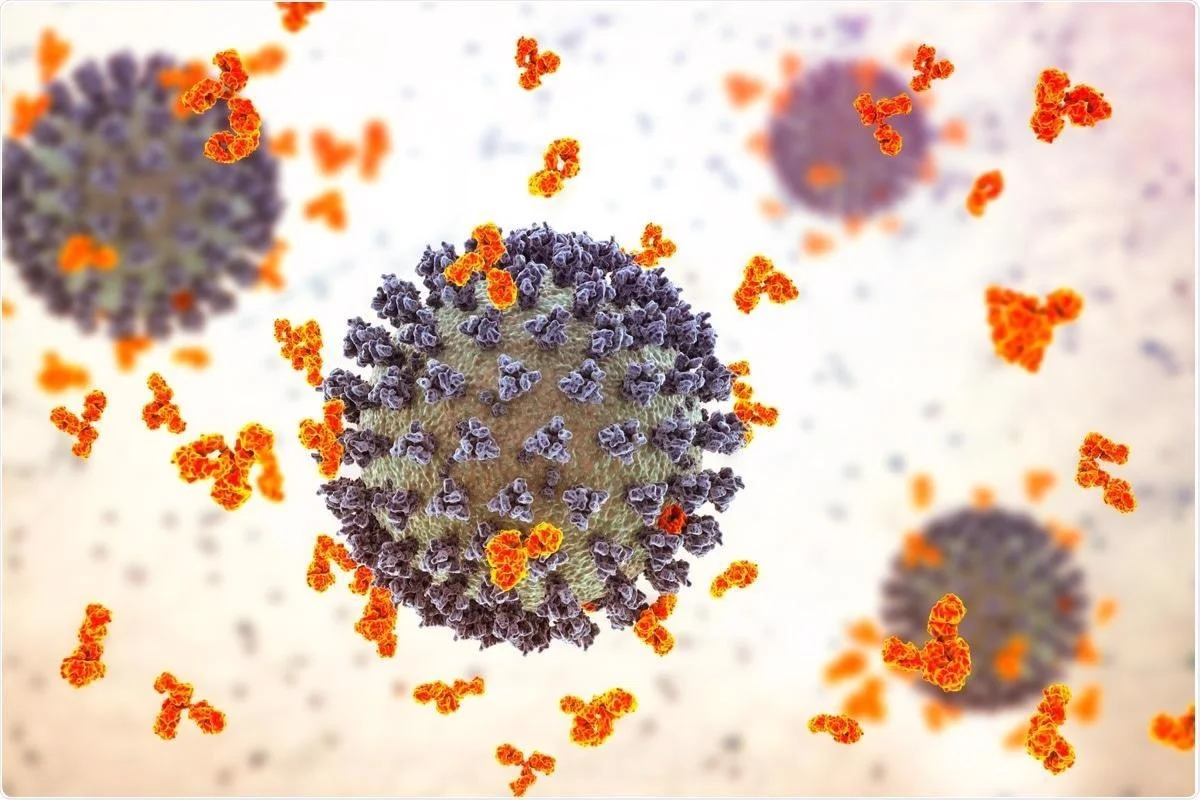
Zoonotic diseases are infectious diseases that can pass from animals to humans. Sometimes, you may not know that an animal is infectious before handling it, so it is always important to wear personal protective equipment.
Some examples of Zoonotic Diseases:
• Avian influenza
• Leptospirosis
• Q Fever
• Ringworm
• Salmonellosis
• Giardia infection
• Roundworm
• Hookworm
• Scabies
• Cat scratch disease
• Avian Tuberculosis
• Hydatid tapeworm (Cystic echinococcosis/hydatid disease)
• Toxoplasmosis
• Staphylococcus intermedius
• Brucellosis
• Hendra Virus (ADD)
Let's explore these diseases in more detail:
Direct contact with an animal infected with a zoonotic disease at an animal care clinic could have the following impacts.
| Avian influenza |
|
| Leptospirosis |
Leptospirosis - infected animals (mice, dogs, rats, cattle and pigs)
|
| Q Fever | Q-fever -usually mild with flu-like symptoms or no symptoms at all. Infection may resurface years later in a small percentage of people, which can be a deadly form of Q-fever, which can include damage to the: • Heart • Liver • Brain • Lungs |
| Ringworm | Ringworm - rash caused by a fungal infection. May have: • itchy, circular rash • clearer skin in the middle. |
| Salmonellosis | Salmonellosis - diarrhea, fever and stomach cramps. |
| Giardia infection | Giardia infection - stomach cramps, bloating, nausea and bouts of watery diarrhea. A microscopic parasite causes giardia infection. |
| Roundworm | Roundworm - roundworms are parasites that need to live in the body. These parasitic infections can cause diarrhea and fever. |
| Hookworm | Hookworm – itching and a localised rash are often the first signs of infection. Heavy infection may result in abdominal pain, diarrhea, loss of appetite, weight loss, fatigue, and anemia. |
| Scabies | Scabies is an itchy skin condition caused by a tiny burrowing mite called Sarcoptes scabiei. Intense itching occurs in the area where the mite burrows. |
| Cat scratch disease | Cat scratch disease - an infection caused by a kind of bacteria called Bartonella henselae. • Red bump, sore, or blister at the site of the scratch or bite • Fever • Headache • Fatigue • Poor appetite • Swollen glands (lymph nodes) |
| Avian Tuberculosis | Avian Tuberculosis - a bacterial infection that spreads slowly. Affects captive birds more than wild birds. It’s contracted when humans ingest food or water contaminated with faeces from infected birds, causing: • Local wound • Swelling near the site of infection |
| Hydatid tapeworm (Cystic echinococcosis/hydatid disease) | Hydatid tapeworm (Cystic echinococcosis/hydatid disease) People infected with E. granulosus develop one or more hydatid cysts. Signs include: • Abdominal pain • Nausea and vomiting • Anorexia • Weight loss • Weakness |
| Toxoplasmosis | In many cases, the disease is asymptomatic. The main threat is to the human foetus via pregnant women's placenta being exposed. Exposure can cause no illness through to the death of an unborn child. Symptoms in adults/children: • Swollen lymph glands • Muscle aches and pains • Headache • Fever • Inflammation of the lungs • Inflammation of the heart muscle • Inflammation of the eye |
| Staphylococcus intermedius | Staphylococcus intermedius • Skin abscesses |
| Brucellosis | Brucellosis Flu-like symptoms include: • Fever • Chills • Headache • Weakness • Joint and muscle pain • Generalised aches |
| Hendra Virus (ADD) | Inflammation of the liver and spleen, as well as gastrointestinal or respiratory symptoms, may also occur. |
